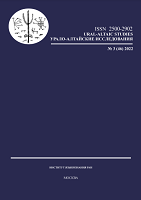Компаративно-аттенуативная полисемия в финно-угорских языках
Comparative-attenuative polysemy in Finno-Ugric languages
Author(s): Maria O. CheremisinovaSubject(s): Comparative Linguistics, Descriptive linguistics, Finno-Ugrian studies
Published by: Институт языкознания Российской академии наук
Keywords: Attenuative; comparative construction; comparative marker; Finno-Ugric languages; polysemy;
Summary/Abstract: The topic of this paper is comparative and attenuative polysemy in Finno-Ugric languages. In some Finno-Ugric languages comparative markers have attenuative meaning (‘a little bit, slightly’) as well. This paper focuses on three markers exhibiting such a polysemy: -ges in Beserman (Permic), -šək in Kazym Khanty (Ugric) and -rak in Hill Mari (Mari). These markers can be used in comparative constructions, have attenuative function and can be attached to the markers of negation. The markers can be used crosscategorically, therefore I also describe compatibility of the markers in different functions. In comparative constructions, all of the markers can be attached to adjectives and adverbs, while in Beserman it is also possible for the marker -ges to be combined with verbs, nouns and pronouns. However, in Kazym Khanty the marker -šək has attenuative meaning even in comparative constructions. In attenuative function, the markers in all three languages can attach to adjectives, adverbs, postpositions (or relational nouns), while in Beserman and Hill Mari verbs can be modified by the markers as well. Finally, comparative-attenuative markers in all of the languages can be attached to the markers of negation. In this function, the most common context allowing the use of the marker is the context meaning ‘not yet’: it appears in all of the described languages. In Kazym Khanty the marker -šək can also express the meaning of emphatic negation (‘no way’) when making a reference to future or present.
Journal: Урало-алтайские исследования
- Issue Year: 2022
- Issue No: 03 (46)
- Page Range: 75-95
- Page Count: 21
- Language: Russian

